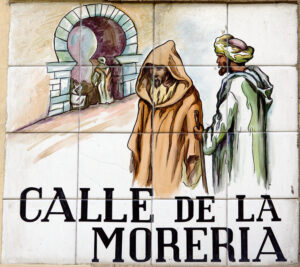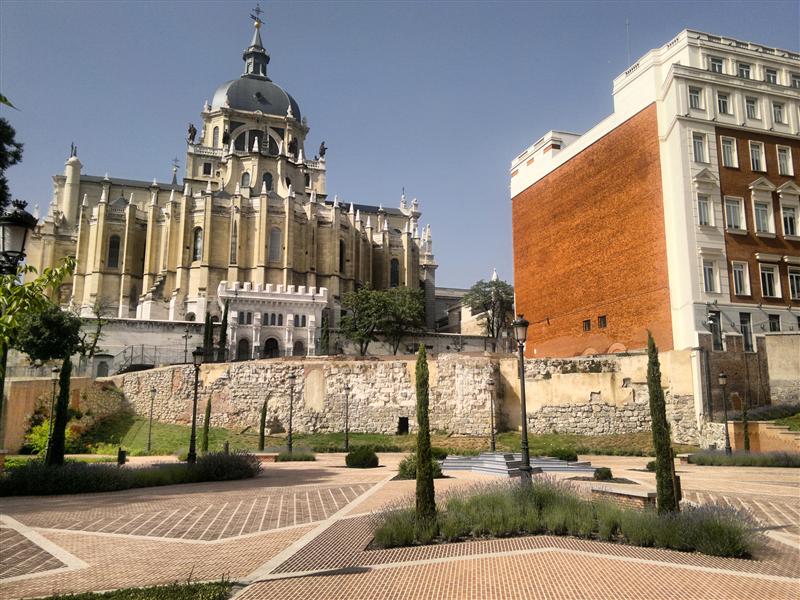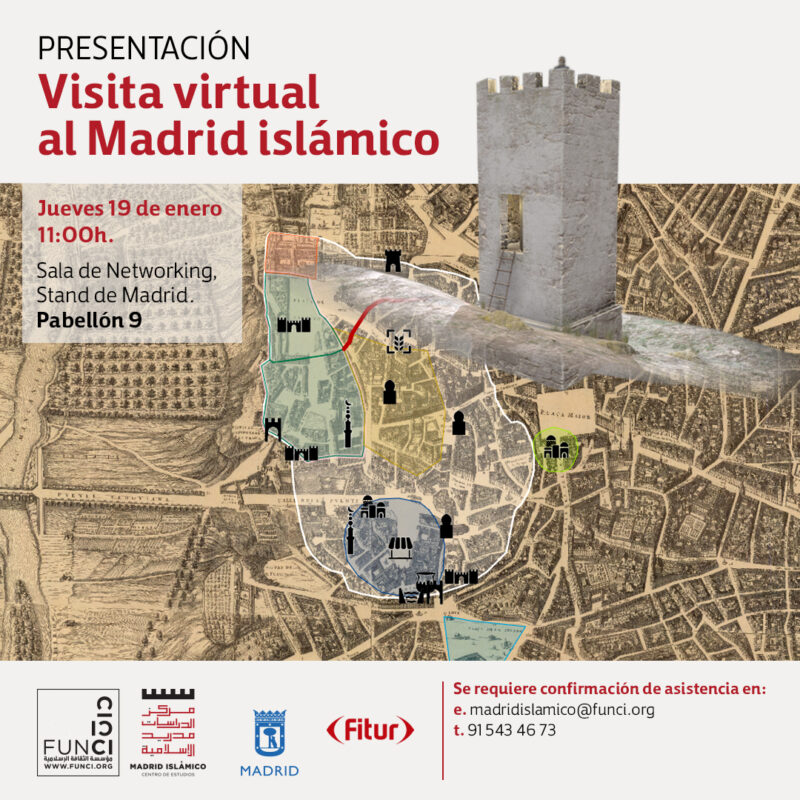Communications
Introducing the new virtual FUNCI’S tour of Islamic Madrid
The Centre for Studies on Islamic Madrid (CEMI), in collaboration with the Madrid City Council, participated in the international tourism trade fair, FITUR, in Madrid on 19 January 2023 to introduce its new project on historical virtual tour.
The event presented a new virtual tour of the Islamic Madrid to professionals of the tourism sector. This is an innovative project from the Islamic Culture Foundation (FUNCI), and the result of the research efforts carried out by CEMI. This visit takes place on an interactive map, through which it is possible to visit the most significant places of the Andalusi and Mudejar Madrid. This is an example of technological innovation applied to the tourism and cultural sector, through the use of tools such as 3D reconstructions of the heritage that is not visible today. This initiative is a sample of the multiple options that the Islamic Madrid offers us today.
Interactive map
Over the last year, CEMI has carried out a research and documentation work to inventory the most significant heritage elements of Islamic Madrid. The results obtained have been included in a map that locates each of these remains. The possibilities offered by technological innovation have made it possible to compare medieval Madrid with today’s Madrid. We can even locate in real time, through geolocation, the most emblematic places, such as the Great Mosque, the Alcazar or the hypothetical enclosures of the Moorish quarters.
 In this way, by interacting with the map, visitors learn about the original enclosure of the city, its walls, the maqbara (cemetery) or the watchtower from the Taifa period, among other places belonging to the Islamic Madrid. The map also offers a general description of each of the heritage elements included, with an option to access a more detailed inventory file, completed with a specific bibliography.
In this way, by interacting with the map, visitors learn about the original enclosure of the city, its walls, the maqbara (cemetery) or the watchtower from the Taifa period, among other places belonging to the Islamic Madrid. The map also offers a general description of each of the heritage elements included, with an option to access a more detailed inventory file, completed with a specific bibliography.
Over the last year, the CEMI has carried out a research and documentation work to inventory the most significant heritage elements of Islamic Madrid.
The virtual tour can be carried out on different types of map: satellite, street or historical, based on Teixeira’s map from the 17th century. With these options, it is easier to understand the dimensions and locations of Islamic Madrid in comparison with the present-day city.
A virtual Museum
One of the main innovations by the Centre for Studies on Islamic Madrid, within the framework of research and dissemination work, is the creation of a Virtual Museum, which gives access to 3D recreations of pieces and monuments linked to the capital’s Islamic past.
The digital reconstruction of the 11th century Taifa (a political-administrative division of the Iberian Peninsula that emerged during the period of Al-Andalus after the dissolution of the Caliphate of Córdoba) watchtower located in the Plaza de Oriente car park is a first step towards this goal. Through a 3D viewer you can appreciate its dimensions and main characteristics, go inside and understand what the defensive towers of the time would have been like.

For this purpose, we have worked together with archaeologists and specialists in virtual reconstruction, so that the result is as rigorous and close to reality as possible. The difficulties that this medieval monument presents today, due to its difficult access and scarce signposting, make this work even more necessary to enhance the value of part of Madrid’s forgotten heritage.
One of the main innovations by the Centre for Studies on Islamic Madrid, within the framework of research and dissemination work, is the creation of a Virtual Museum, which gives access to 3D recreations of pieces and monuments linked to the capital’s Islamic past.
3D virtualisation of the Islamic city wall
In line with the goal of recovering memory through digitisation and technological innovation, FUNCI is collaborating with the Siglo22 Foundation in the European project Erasmus +: Art and Culture Recorded for e-Ternity. This initiative is based on a collaboration agreement signed in 2021. Its aim is the promotion among the students of interculturality and respect between the different cultures, religions and thoughts that coexist in Europe .
This is a Virtual Reality project involving institutions from the Netherlands, Belgium, Italy, Czech Republic and Spain. It aims at virtualising monuments from each of these countries. In the case of Spain, considerable importance has been given to Islamic heritage.
Through its interdisciplinary work, the Centre for Studies on Islamic Madrid aims to recover the historical memory in different fields: education, technological innovation, tourism and sustainability, among others.
Among the monuments selected, we find the 9th century Islamic wall, located in the Emir Mohamed I Park. Also, as part of the intangible Islamic heritage, it was decided to integrate the knowledge on Al-Andalus botany, through an ethnobotanical tour located in this same park. This immersive experience, achieved through the use of 3D glasses, allows you to visit and learn more about this place through its interactive games.

To complement the knowledge on the Islamic past of Madrid and its region, the project also includes the participation of the Regional Archaeological Museum. Both the room dedicated to the Andalusi Madrid and the exhibition on the city’s maqbara are subject to a virtualisation that will bring museums and history closer to classrooms and the general public.
Forthcoming CEMI actions
Through its interdisciplinary work, the Centre for Studies on Islamic Madrid aims to recover the historical memory in different fields: education, technological innovation, tourism and sustainability, among others.
This presentation is a sharing of the many possibilities that the city’s Al-Andalus past offers today, as well as the progress and results obtained by CEMI in the five years since its creation.
The virtual visit to Islamic Madrid is consolidated as a further step in bringing the city’s Muslims origins closer. It also acquires an innovative character that allows Madrid’s Islamic heritage to be internationalised and positioned in large-scale European projects.


